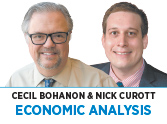Subscriber Benefit
As a subscriber you can listen to articles at work, in the car, or while you work out. Subscribe Now A friend of ours notes that we humans have a hard time processing probabilistic thinking. “People want to believe either that X must be mandated, or that X is useless.”
A friend of ours notes that we humans have a hard time processing probabilistic thinking. “People want to believe either that X must be mandated, or that X is useless.”
The reactions to the recent Bangladeshi experiment on masking and COVID-seroprevalence confirms this. (COVID-seroprevalence is COVID-19 antibody presence in blood samples.) Some claim the study provides “unequivocal” and “gold-standard proof” of the efficacy of masks, while others claim it should be “laughed out of a 7th grade science fair.” So, which is correct?
The study used 600 villages in Bangladesh with total adult population of 340,000-plus. Half of the villages were exposed to a mask-wearing promotion campaign and given free masks; half were not. In the villages with the mask campaigns, 43% of adults wore masks in public venues and 29% socially distanced, whereas only 13% wore masks and 24% socially distanced in villages that had no campaigns.
Moreover, blood samples taken at a later date revealed that, in campaign villages where surgical masks were offered, the seroprevalence of the COVID-19 virus was 0.67%, whereas it was 0.76% in villages with no campaign. In campaign villages where cloth masks were provided, seroprevalence was 0.74%.
Researchers routinely note when taking samples among different groups, it is possible that measured differences among the group samples are attributable to random luck. Suppose a large opaque vase contains 100,000 marbles, 50,000 red and 50,000 blue. Have a blindfolded person draw out 40 marbles. Is it possible that the person would draw 38 red and two blue? Possible, but very unlikely. Statistical theory can calculate those odds, which in this case would be under 1%.
So, could the differences in seroprevalence of COVID-19 reported above be attributed to chance? Could be, but the question is, what are the odds? The data indicate that, between the no-campaign and surgical-masks villages, the odds are under 5%. However, between no-campaign villages and cloth-masks villages, the odds are around 50%. The evidence is pretty strong that the campaign with surgical masks yielded around a 10% reduction in seroprevalence, but not so much for cloth masks.
So here is what Bohanon and Curott conclude: Masks reduce COVID transmission but don’t eliminate it. The reduction is not that huge. Masks are a good tool but not a silver bullet. We’d neither say they are useless, nor suggest mandating universal mask wearing until COVID is no longer around. Just our take. In a probabilistic world, it is never all-or-nothing.•
__________
Bohanon and Curott are professors of economics at Ball State University. Send comments to [email protected].
Please enable JavaScript to view this content.

You guys are quite intelligent, and this article points to a valid issue with the average Joe not understanding much about statistics. But it’s hard to ignore the glaring omission of what is obviously the much more important issue – vaccines WORK and there’s NO doubt about those statistics!